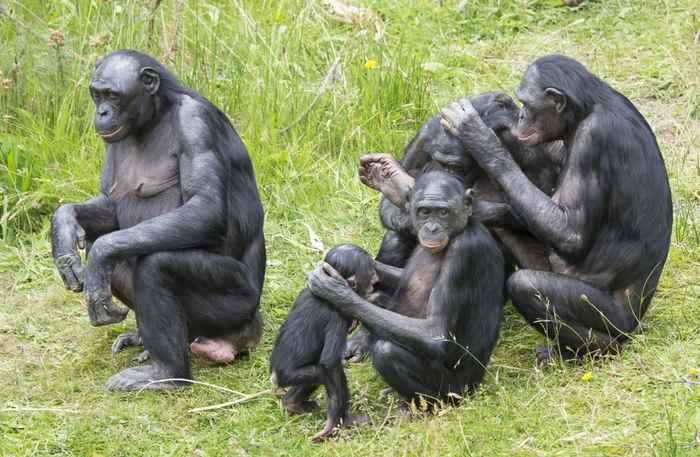Bonobos, unlike humans, are more interested in the emotions of strangers than individuals they know
11 January 2023

Scientists like to study the behaviour and other characteristics of bonobos and chimpanzees, in order to gain more insight into our own evolutionary history. That is also what drove Evy van Berlo when she decided to look at the evolutionary basis of emotions in humans and closely related great apes for her PhD research. Van Berlo is now working as a postdoctoral researcher at the University of Amsterdam but conducted her PhD research at Leiden University. For one of her studies, together with lead researcher Mariska Kret of Leiden University and with assistance of the bonobo caretakers at the Dutch zoo Apenheul, she looked at how bonobos and humans react to photos of conspecifics with different types of emotional expressions. The results of that study have now appeared in the journal Emotion published by the American Psychological Association.
Van Berlo trained bonobos in the Apenheul, a zoo fully focused on primates, to press a dot on a screen. After touching the dot, two images appeared very briefly. The images showed bonobos from the same group as well as unfamiliar conspecifics. Some images were neutral, while others showed an expression or activity clearly associated with a type of emotion, such as fear, play, or sex. A dot then again appeared behind one of these two images, and the apes had to touch it as quickly as possible. Pressing the dot was then followed by a reward in the form of a piece of apple. The system kept track of how quickly the bonobos pressed the dot that appeared after seeing the different photos. The idea behind this study was that apes would be faster at touching the dot that appears behind the photo that immediately grabs attention.
"Can you react faster than a bonobo?"
Van Berlo and her colleagues also conducted a similar study with human visitors of the Apenheul. The people were presented with the same task, with photos of strangers or a person with whom they visited the zoo that day, and with varying facial expressions on the photos (neutral, happy, scared, angry, etc.). The challenge for the human visitors was, "Can you react faster than a bonobo?". Reaction time was also examined here, with a shorter reaction time being interpreted as the result of the photo shown at that moment drawing the most attention.
'In these studies, we saw that both humans and bonobos react more quickly to photos of conspecifics with an emotional charge than neutral photos,' says Van Berlo. ‘That is what we expected: it makes sense given that we are both social animals. Yet there was also a remarkable difference. We humans are mainly focused on emotionally charged photos of people we know, while the attention of bonobos is focused on studying emotionally charged photos of unfamiliar others.'
Evolutionary difference
This finding fits with previous studies that show that bonobos are a so-called xenophilic animal species: they are more attracted to unfamiliar than familiar conspecifics. For example, unlike humans, they will share food more quickly with bonobos that are strangers to them than with individuals they know. Van Berlo: 'Scientists have suggested that this is an evolutionary difference that has arisen due to differences in the living environment. Bonobos live in a relatively stable ecological environment in Congo, where there is enough food available. Under those circumstances, there is less need for competition with other groups and peaceful interaction with strangers might even be beneficial for the conservation of the species. Early humans, on the other hand, lived in nomadic groups that had to compete with other groups of humans for food. Under such circumstances, it is probably evolutionarily more beneficial to favour individuals from your own group over strangers.'
According to Van Berlo, it would be interesting to repeat this study with other great apes. Bonobos are known as the most peaceful ape species. In appearance, bonobos are very similar to chimpanzees - they were formerly known as pygmy chimpanzees - but their social organization and behaviour are very different. For example, chimpanzees are a lot more competitive. And with chimpanzees, males are at the head of a group, while in bonobo groups the females are dominant and in charge. Van Berlo: 'It would be nice to test how other primates with different social organizations view emotional expressions of familiar group members and strangers through a similar study. With chimpanzees, for example, I would expect them to be more interested in the emotions of individuals they know than the emotions of strangers.'
Publication details:
Evy van Berlo, Thomas Bionda en Mariska E. Kret (2023). Attention Toward Emotions Is Modulated by Familiarity With the Expressor: A Comparison Between Bonobos and Humans. Emotion, 23(1). DOI: https://doi.org/10.1037/emo0000882